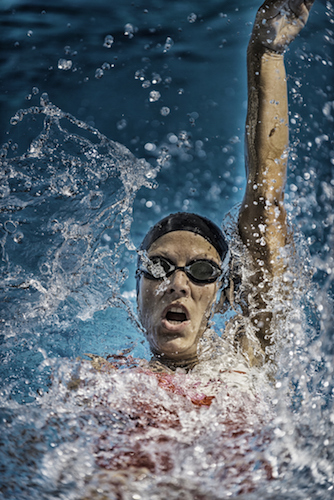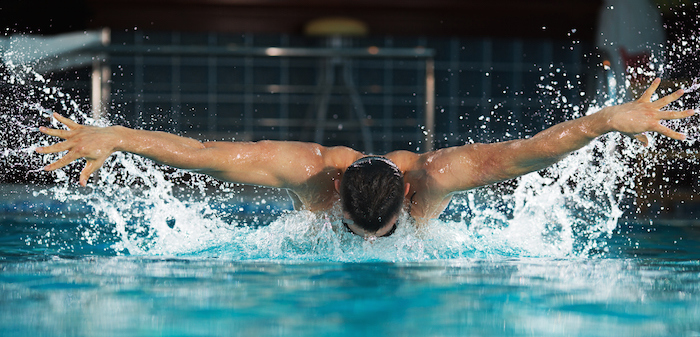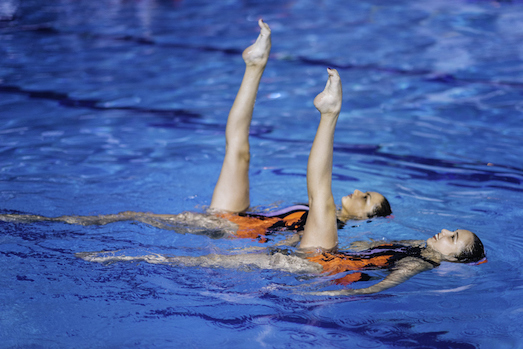Swimming is moving along in water.
Swimmers use their arms and legs to move through the water.
There are many different swimming strokes: freestyle, backstroke, breaststroke and butterfly.
To start most races, swimmers dive into the pool.
A dive into the pool starts the race
© Getty images
Swimming is moving along in the water by moving the arms and legs. There are different swimming styles or strokes.
Freestyle
Freestyle is the fastest swimming stroke. Some freestyle races are short. The 50 metres freestyle is the shortest. The 1500 metres is the longest freestyle event and at the Olympic Games it is an event for men.The longest Olympic freestyle event for women is the 800 metres freestyle.
Swimmers dive into the pool to start a freestyle race.
There was a marathon swimming event at the Olympic Games in 2008 for female and male athletes. Swimmers swam 10 kilometres! That’s a long way!
Breaststroke swimmers kick their legs like frogs
©Getty
Breaststroke
Some swimmers swim breaststroke. They move both hands forwards, outwards and then backwards. The legs are kicked like those of a frog.
Backstroke. ©Getty
Backstroke
Backstroke swimmers swim on their backs and rotate, or turn, their hands backwards. They kick their legs up and down.
They do not dive into the pool to start the race, but hold onto the wall and push themselves backwards when the starting siren sounds.
Butterfly
Butterfly swimmers lift both arms out of the water ©Getty
To swim butterfly stroke, the swimmer lifts both arms out of the water and flings them forward. The legs kick a dolphin kick. There are 100 metre and 200 metre butterfly swimming events for men and for women.
There are swimming relay races for teams of swimmers.
Artistic swimming by two swimmers is called ‘a duet’ ©iStock
Artistic swimming
Once called synchronised swimming, artistic swimming is an event for women. Teams of swimmers make shapes and patterns in the water. Sometimes the swimmers are under the water. They must be able to hold their breath for a long time.
There are solo (one person) events as well as events for two swimmers (called duets) and for teams.
Watch a video here
Fun facts from Australian swimming history
Swimming was a popular activity in sea baths on Sydney Harbour from about 1830, but men and women were not allowed to swim in the pool at the same time. It was thought to be rude!
Men often swam nude (without clothes). Women wore bathing dresses!
Women wore uncomfortable swimming dresses and hats. They dressed and undressed in bathing boxes like this.
In 1833 laws were passed that said that no one could swim at the beach in daylight.
In 1900 people who swam or even lay on the beach could be arrested.
Freddie Lane was Australia's first Olympic swimming champion. He won 2 gold medals at the Paris Games in 1900. One of his medals was for an obstacle race in which competitors climbed over a pole, scrambled over a row of boats, and swam under another row of boats.
Fanny Durack was Australia's first female Olympic champion. She won a gold medal in 1912, the year that swimming became an Olympic sport for women.
More history of swimming
Relics from ancient Egypt show people swimming. There is evidence that swimming was a feature of daily life in ancient Greece, although it was not a sport. There is no evidence that swimming was a part of the ancient Olympics.
Swimming competitions began in Japan in 1603.
But until the 1800s, Europeans, who believed that water spread diseases, did not swim.
The first competition in Europe was in 1862 and the stroke was the breaststroke.
How swimmers move through the water for each swimming style. ©Getty
It is always a good idea to use more than one source of information, so here are some others for you to investigate
Watch some swimming events at the 2020 Olympics
Read about swimming at the Paris Olympics 2024
Marathon Swimming
This event began in Beijing at the 2008 Games.
Swimmers swim in open water such as in the sea, in rivers and on lakes. The event is over a distance of 10 kilometres.









